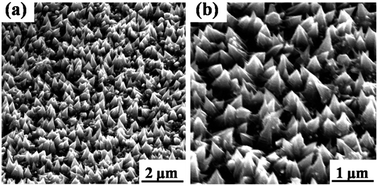Ionic liquid electrodeposition of Ge nanostructures on freestanding Ni-nanocone arrays for Li-ion battery†
Abstract
With the growing demand for portable and wearable electronic devices, it is imperative to develop high-performance Li-ion batteries with long lifetimes. The deployment of three-dimensional (3D) nanostructured materials on current collectors has recently emerged as a promising strategy for preparing high-performance Li-ion batteries. We develop a simple and efficient method for fabricating ultrathin and flexible 3D Ge–Ni nanocone arrays (NCAs) electrode materials using a two-step electrodeposition process. With uniform NCAs as the substrate, Ge nanoparticles were deposited from ionic liquid at room temperature. The electrode can be removed from the carrier film. Thus, the resulting freestanding electrode can be as thin as 3 μm and exhibits specific capacity up to 500 mA h g−1 after 100 cycles at 0.1 C, the rate capability at 1 C and 2 C rates of 700 mA h g−1 and 400 mA h g−1, respectively. This improved electrochemical performance is the result of the 3D NCAs enhanced electron migration and electron transport paths while also providing sufficient elasticity to buffer the volume expansion of the Ge nanoparticles.


 Please wait while we load your content...
Please wait while we load your content...